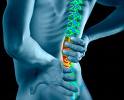
One of the most common reasons why patients visit our office is for back pain. Statistics suggest that low back pain provokes major dysfunction and disability in the adult population. In fact, back pain affects nearly 80% of all adults at one point or another! After cardiovascular disease, chronic back pain is the most common reason for workers disability and early retirement.
Why is Back Pain So Common?
There are many reasons. These include:
* Repetitive stress injuries
* Bad Posture, such as scoliosis, forward head posture, hunched back, etc.
* Muscle imbalances, including poor core strength
* Active trigger points
* Trauma
* Muscle Spasms
* Work activity, such as prolonged sitting and standing
* Infection
* Disc injuries, arthritis, nerve impingment, & degeneration
* Sedentary lifestyle causign deconditoned muscles
* Loss of foot arches causing abnormal biomechanics
* Neoplasms (tumors, growths, etc.)
To add insult, we are humans that walk upright and are constantly exposed to the affects of gravity, which may make existing back problems worse because of the increased load (pressure) on the discs, ligaments, tendons, and other tissues.
Where Exactly Does it Hurt?
The spine is divided into three major sections: the cervical spine, the thoracic spine and the lumbar spine. Each section is associated with distinct problems and kinds of pain.
In this section, we will be review thoracic and lumbar pain. To review the cervical spine, click here.
Thoracic Spine:
While the range of motion in the thoacic spine is very limited by the ribs, it is also receives vital support from the ribs. This is why the thoracic spine is far less often a source of pain.
However, the costovertebral articulations – the points of attachment between the ribs and the thoracic vertebrae – represent a weak spot in the thoracic spine. These joints are subject to continuous motion on account of respiration. That is why the pain originating in this area of the spine tends to radiate into the thoracic cavity. The intensity of this pain sometimes leads people to believe they are experiencing the onset of a heart attack.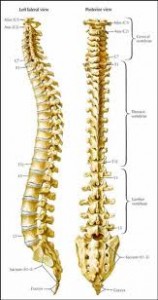
Lumbar Spine:
.
Most cases of back pain originate in the lowest section of the spine.
.
The vertebrae in our lumbar spine are exposed to tremendous stress when we are in an upright position. The intervertebral discs that act as a buffer and spring lose a portion of their fluid every day and shrink, or flatten out, as a result. While the fluid in the discs is replenished at night while we sleep in a horizontal position, the degree to which the discs are replenished diminishes as we grow older and the shrinkage becomes a permanent condition.
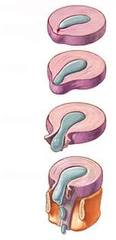 With time, continual stress and strain can lead to serious disc injuries. The lumbar spine is the most common site of disc herniation. When a disc herniates or ruptures, a part of it presses out against one of the large nerves in the spine, causing intense pain that often radiates down into the legs.
With time, continual stress and strain can lead to serious disc injuries. The lumbar spine is the most common site of disc herniation. When a disc herniates or ruptures, a part of it presses out against one of the large nerves in the spine, causing intense pain that often radiates down into the legs.
One type of back pain is referred to as discogenic pain. This type of pain is thought to arise when the lumbar intervertebral discs begin to deteriorate and when blood vessels and nerves grow into the disc tissue, resulting in an increase in the internal pressure.
While the causes of back pain are as various as they are complex, they are usually related to degenerative processes that occur in connection with wear and tear and/or from abnormal loading of the spine, such as with bad posture.
The Most Common Diseases Originating Directly From the Spine include:
- Wear (osteoarthritis) in the joints of the spine (facet joint osteoarthritis)
- Vertebral disc protrusion
- Vertebral disc herniation
- Foraminal stenosis
- Spinal canal stenosis
- Vertebral disc deterioration (discogenic pain)
- Osteoporosis and vertebral body fractures
- Osteochondrosis
- Spondylolithesis
Each of these various conditions may cause back pain, and may occur in combination with other conditions or factors. Some of the conditions can trigger very complex pain responses, with pain occurring simultaneously in the back, buttocks, and into the lower extremities.
Risk Factors
The chances that an individual will one day suffer from serious back pain are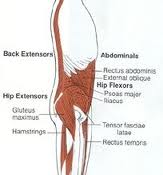 influenced by several factors, including:
influenced by several factors, including:
* Genetic disposition
* Bad posture
* Repetitive or prolonged motion
* Obesity
* Inactivity
A lack of physical activities is almost always involved because the spine is supported by the muscles in the back and stomach. If these groups of muscles are too weak, then back pain will be virtually unavoidable.
How Do We Determine Your Problem?
Here at Performance Chiropractic, our first order of priority is to correctly diagnose your condition. As you can see from the above information, origins are many. To do so, we use the following tools:
- A comprehensive orthopedic and neurological evaluation – includes assessment of posture, thoracic and lumbar range of motion, reflexes, assessment of nerve function, checking for muscle dysfunctions or imbalances, identifying trigger points, and more.
- Imaging studies when needed (such as X-ray or MRI) – helps assess posture, abnormal spinal curvatures, level of degeneration (bone spurs, disc decay), identification of abnormal growths, etc.
- Lab Work, as indicated – to assess general health status, inflammatory markers, vitamin/mineral deficiencies, etc.
- 15 years of clinical experience – We have treated patients with low back pain for over a decade. As such, we are familiar with common patterns and issues that typically plaque low back pain sufferers.
Our Approach?
Most back pain, even chronic back pain, is typically treated with medication, rest, injections, or in some cases, surgery. Unfortunately, many times these back pain treatments fail to address the underlying problems – AND they all have negative side effects.
Medications of course have potential side effects and drug interactions. Rest tends to worsen and prolong the symptoms. Injections can weaken ligaments and/or other deep tissues, in the long run making them more susceptible to injury. Surgery typically involves either removing part or all of a vertebra or disc, or fusing multiple vertebrae together – which often leads to other back problems in the future.
That said, there are indeed circumstance where the above treatments are necessary. For this reason, there are general practitioners, orthopedists, and neurosurgeons that we work with and refer to when needed.
However, the downsides of these traditional treatments can many times be easily be avoided with a safe, drug-free approach to healing back pain.
According to some studies, most spinal surgeries for acute lower back problems should be rarely performed. Many people who have had back surgery report a recurrence of their symptoms within a year or two of the operation and may return to the operating table. In some cases, the surgery makes no difference whatsoever. In other cases, it does bring long-term relief.
Our approach is to determine the cause of your problem. For example, although you may have an injured disc, unless you had trauma such as from an accident, in most cases the origin of this damaged disc can be from the abnormal spinal stress that developed over the years.
.
This could have been from the loss of or an excessive low back curve, abnormal posture, dropped foot arches, excessive scar tissue around a joint, etc.
.
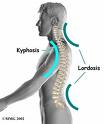
Other low back issues may involve pain from muscular 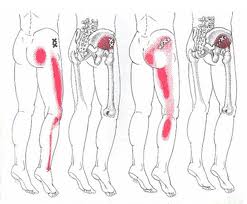 origins, such as exist with muscle imbalances or with active trigger points, which are knots with a muscle that provoke both local pain and referred pain to other parts of the body away from its location.
origins, such as exist with muscle imbalances or with active trigger points, which are knots with a muscle that provoke both local pain and referred pain to other parts of the body away from its location.
.
In such cases, a corrective exercise program to detect and correct these imbalances is a must and/or in the second case, soft tissue therapy to release these active trigger points is performed.
.
Why Choose Us?
At Performance Chiropractic we are prepared and well-equipped to treat most back conditions safely and effectively. Our doctor and staff are competent, friendly, and professional.
Our unique approach of treating back pain is based on assessing:
.
1. NEUROLOGICAL STATUS
2. STRUCTURAL ANALYSIS
3. MUSCULAR ANALYSIS
4. FUNCTIONAL FITNESS ASSESSMENTS
5. METABOLIC CONSIDERATIONS
.
This comprehensive look at back pain has allowed us to help hundreds of patients that have been riddled with back issues for years without help elsewhere.
d
See what others have said about our care =>CLICK HERE.
.
If you have unresolved back pain and would like to give us a try, contact us.
.
.
